Do you have a question about the Metz MECABLITZ 48 AF-1 digital and is the answer not in the manual?
Instructions on attaching and detaching the flash unit to/from the camera.
Details on suitable battery types and power sources for the flash unit.
How to turn the flash unit on, off, and recommendations for extended periods.
Explains the automatic standby mode and how to adjust its timing.
Indicates when the flash capacitor is charged and ready to fire.
Shows the "OK" signal for correctly exposed shots in TTL mode.
How the flash unit display illumination is activated and its duration.
Shows the currently selected flash mode on the unit's display.
Displays the calculated flash range based on camera data.
Indicates when the flash unit needs to be switched on or used.
Shows that the flash unit is ready for use.
Advice on handling overexposure or underexposure indicated by the camera.
Simple method for good flash shots using camera's TTL metering.
Digital flash modes based on TTL, using a metering preflash.
Activated automatically for balanced fill-in flash in daylight shots.
Allows manual control of flash output for specific photographic situations.
Enables flash use with shutter speeds faster than the sync speed.
How to adjust flash exposure manually for shots with contrasty backgrounds.
Adjusts reflector angle automatically or manually to match lens focal length.
Extends illumination coverage to 18mm focal length.
Optional accessory for softer lighting effects.
Enables wireless remote control of the flash unit using E-TTL system.
Automatically takes three shots with different flash exposure corrections.
Sets the automatic standby mode duration or deactivates it.
Provides a brief light for assessing shadows and light distribution.
Expands light coverage for softer illumination by reducing reflector angle.
Allows switching the flash range display between metres and feet.
Triggers flash at the end of exposure for motion trails.
Adjusts reflector position to match camera's chip format.
Illuminates subjects softly and reduces harsh shadows by bouncing light.
Uses an integrated card to add highlights, especially in eyes.
Compensates for parallax error and ensures even illumination in close-up photography.
Stores exposure level for a subsequent shot, useful for specific subject details.
Automatically adjusts shutter speed to the flash sync speed for correct exposure.
Triggers flash at the beginning of the shutter time, standard mode.
Triggers flash at the end of the exposure time for motion trails.
Adjusts shutter speed to ambient light for background illumination.
Projects a pattern to assist the camera in focusing in low light.
Instructions on updating the flash unit's firmware via USB.
Restores the flash unit to its factory default settings.
Procedure to maintain the flash capacitor's physical state.
Basic steps to resolve non-functioning or display issues.
Addresses issues with the flash range not appearing on the display.
Explains why the AF measuring beam might not activate.
Issues with the main reflector not automatically adjusting to zoom.
Problems with the aperture not automatically adjusting to the lens.
Warning for potential shadowing due to focal length mismatch.
Reasons why the ETTL flash mode might not be selectable.
Explains why REAR synchronisation may not be available.
Issues where manual exposure correction is not applied.
Problems with automatic switching to the flash sync speed.
Addresses shadows in close-up shots due to parallax or diffuser use.
Causes and solutions for underexposed photographs.
Causes and solutions for overexposed photographs.
Explains why aperture adjustment on the flash unit is not possible.
Details the angles and positions the reflector head can be adjusted to.
Physical specifications of the flash unit.
Lists what is included with the flash unit.
| Product color | Black |
|---|---|
| Color temperature | 5600 K |
| Guide number (ISO 100, set at 35mm zoom) | 38 m |
| Input voltage | 1.5 V |
| Weight | 340 g |
|---|---|
| Dimensions (WxDxH) | 71 x 99 x 137 mm |


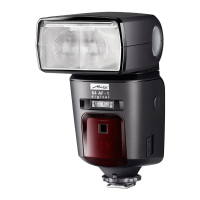
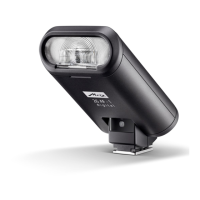
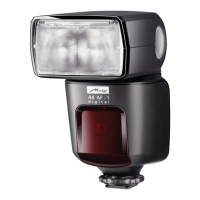
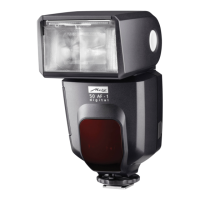
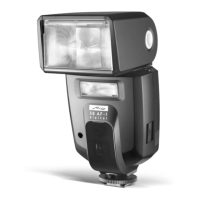
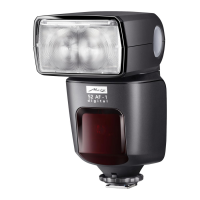
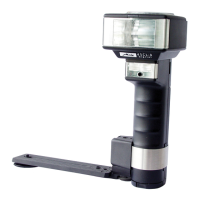
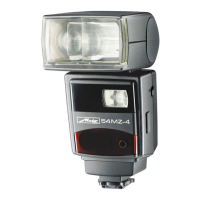
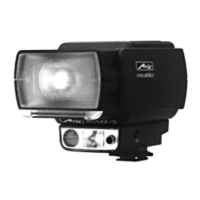
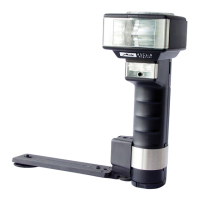
